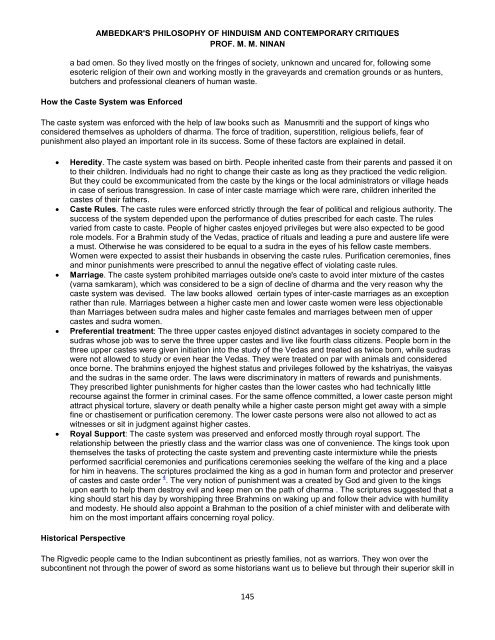Ambedkar-Philosophy of Hinduism
You also want an ePaper? Increase the reach of your titles
YUMPU automatically turns print PDFs into web optimized ePapers that Google loves.
AMBEDKAR'S PHILOSOPHY OF HINDUISM AND CONTEMPORARY CRITIQUES<br />
PROF. M. M. NINAN<br />
a bad omen. So they lived mostly on the fringes <strong>of</strong> society, unknown and uncared for, following some<br />
esoteric religion <strong>of</strong> their own and working mostly in the graveyards and cremation grounds or as hunters,<br />
butchers and pr<strong>of</strong>essional cleaners <strong>of</strong> human waste.<br />
How the Caste System was Enforced<br />
The caste system was enforced with the help <strong>of</strong> law books such as Manusmriti and the support <strong>of</strong> kings who<br />
considered themselves as upholders <strong>of</strong> dharma. The force <strong>of</strong> tradition, superstition, religious beliefs, fear <strong>of</strong><br />
punishment also played an important role in its success. Some <strong>of</strong> these factors are explained in detail.<br />
• Heredity. The caste system was based on birth. People inherited caste from their parents and passed it on<br />
to their children. Individuals had no right to change their caste as long as they practiced the vedic religion.<br />
But they could be excommunicated from the caste by the kings or the local administrators or village heads<br />
in case <strong>of</strong> serious transgression. In case <strong>of</strong> inter caste marriage which were rare, children inherited the<br />
castes <strong>of</strong> their fathers.<br />
• Caste Rules. The caste rules were enforced strictly through the fear <strong>of</strong> political and religious authority. The<br />
success <strong>of</strong> the system depended upon the performance <strong>of</strong> duties prescribed for each caste. The rules<br />
varied from caste to caste. People <strong>of</strong> higher castes enjoyed privileges but were also expected to be good<br />
role models. For a Brahmin study <strong>of</strong> the Vedas, practice <strong>of</strong> rituals and leading a pure and austere life were<br />
a must. Otherwise he was considered to be equal to a sudra in the eyes <strong>of</strong> his fellow caste members.<br />
Women were expected to assist their husbands in observing the caste rules. Purification ceremonies, fines<br />
and minor punishments were prescribed to annul the negative effect <strong>of</strong> violating caste rules.<br />
• Marriage. The caste system prohibited marriages outside one's caste to avoid inter mixture <strong>of</strong> the castes<br />
(varna samkaram), which was considered to be a sign <strong>of</strong> decline <strong>of</strong> dharma and the very reason why the<br />
caste system was devised. The law books allowed certain types <strong>of</strong> inter-caste marriages as an exception<br />
rather than rule. Marriages between a higher caste men and lower caste women were less objectionable<br />
than Marriages between sudra males and higher caste females and marriages between men <strong>of</strong> upper<br />
castes and sudra women.<br />
• Preferential treatment: The three upper castes enjoyed distinct advantages in society compared to the<br />
sudras whose job was to serve the three upper castes and live like fourth class citizens. People born in the<br />
three upper castes were given initiation into the study <strong>of</strong> the Vedas and treated as twice born, while sudras<br />
were not allowed to study or even hear the Vedas. They were treated on par with animals and considered<br />
once borne. The brahmins enjoyed the highest status and privileges followed by the kshatriyas, the vaisyas<br />
and the sudras in the same order. The laws were discriminatory in matters <strong>of</strong> rewards and punishments.<br />
They prescribed lighter punishments for higher castes than the lower castes who had technically little<br />
recourse against the former in criminal cases. For the same <strong>of</strong>fence committed, a lower caste person might<br />
attract physical torture, slavery or death penalty while a higher caste person might get away with a simple<br />
fine or chastisement or purification ceremony. The lower caste persons were also not allowed to act as<br />
witnesses or sit in judgment against higher castes.<br />
• Royal Support: The caste system was preserved and enforced mostly through royal support. The<br />
relationship between the priestly class and the warrior class was one <strong>of</strong> convenience. The kings took upon<br />
themselves the tasks <strong>of</strong> protecting the caste system and preventing caste intermixture while the priests<br />
performed sacrificial ceremonies and purifications ceremonies seeking the welfare <strong>of</strong> the king and a place<br />
for him in heavens. The scriptures proclaimed the king as a god in human form and protector and preserver<br />
<strong>of</strong> castes and caste order 4 . The very notion <strong>of</strong> punishment was a created by God and given to the kings<br />
upon earth to help them destroy evil and keep men on the path <strong>of</strong> dharma . The scriptures suggested that a<br />
king should start his day by worshipping three Brahmins on waking up and follow their advice with humility<br />
and modesty. He should also appoint a Brahman to the position <strong>of</strong> a chief minister with and deliberate with<br />
him on the most important affairs concerning royal policy.<br />
Historical Perspective<br />
The Rigvedic people came to the Indian subcontinent as priestly families, not as warriors. They won over the<br />
subcontinent not through the power <strong>of</strong> sword as some historians want us to believe but through their superior skill in<br />
145


















